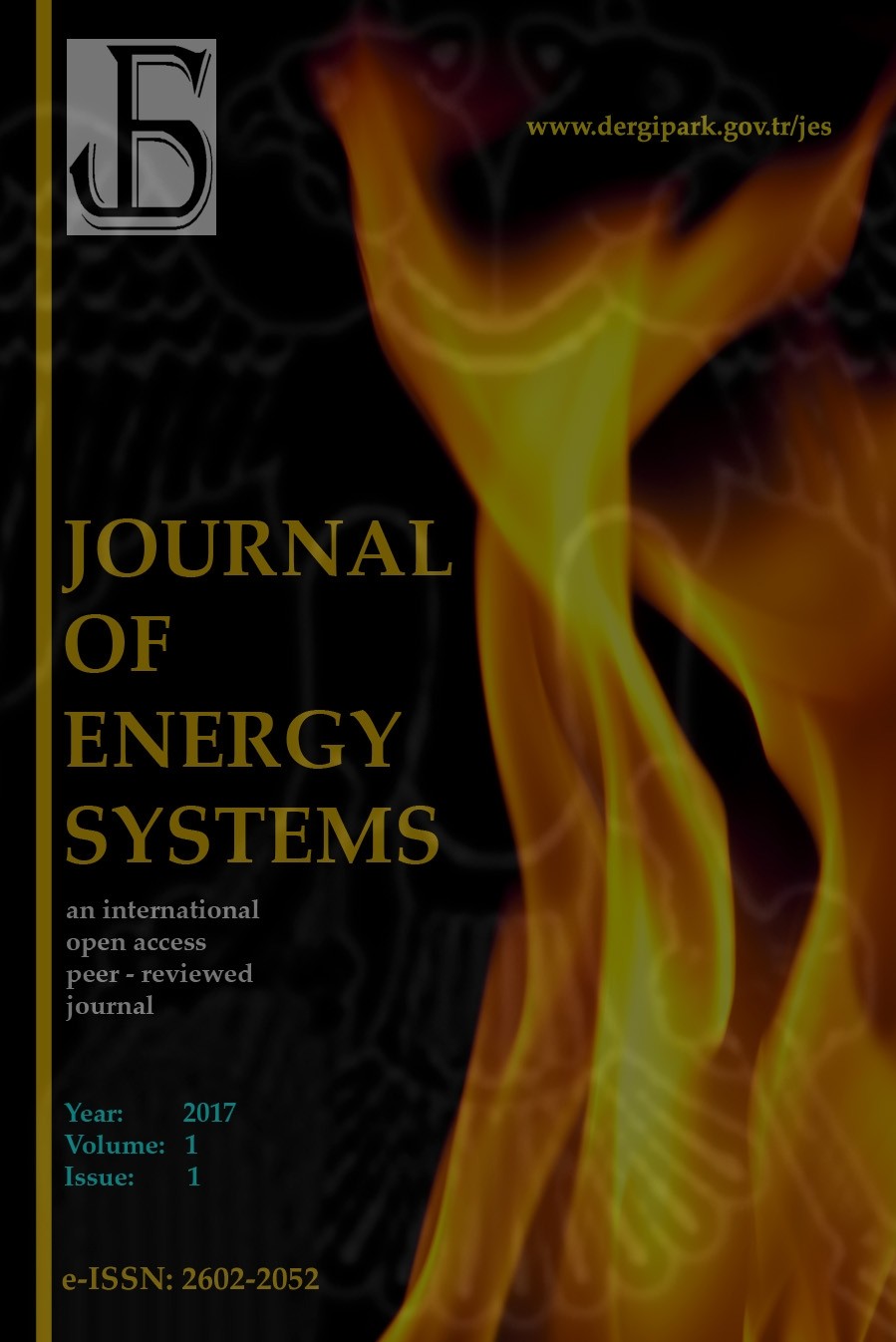Design and feasibility analysis of a solar PV array installation during the construction of high-rise residential buildings
Design and feasibility analysis of a solar PV array installation during the construction of high-rise residential buildings
Electricl energy auditing, Energy efficient construction Green-House gas mitigation, Performance indices, Solar PV system,
___
- [1] Thormark C. The effect of Materials choice on the total energy need and recycling potentiel of a building. Building and Environnent 2016 ; 1 : 1019-1026, DOI : 10.1016/j.buildenv.2005.04.026.
- [2] Pratima Bansal. The corporate challenges of sustainable development. The Academy of Management Executive 2005; I: 122-131, DOI: 10.1016/j.buildenv.2005.04.026.
- [3] Lotfabadi P. Solar considerations in High-rise buildings. Energy and Buildings.2014;89:183-195. DOI:org/10.1016/j.enbuild.2014.12.044.
- [4] Ramesh T, Ravi Prakash, K.K. Shukla. Life cycle Energy analyses of buildings. An overview. Energy and Buildings 2010; 42: 1592–1600. DOI:org/10.1016/j.enbuild.2010.05.007.
- [5] Leif Gustavsson, Anna Joelsson, Roger Sathre.Life cycle primary Energy use and Carbon émissions of an eight-story wood-framed appartements building, Energy and Buildings 2010 ;42 :230–242. DOI:org/10.1016/j.enbuild.2009.08.018.
- [6] Horvath A, C. Hendrickson. Steel versus Steel-Reinforced Concrete Bridges. Environmental Assessment. Journal of Infrastructure Systems 1998; 4 : 111-117. DOI: 10.1061/(ASCE)1076-0342(1998)4:3(111).
- [7] Treloar G.J.A hybrid life cycle assessment method for construction”, Construction Management and Economics, 2000; 18: 5 - 9. DOI.org/10.1080/014461900370898.
- [8] Treloar, G.J., P.E.D. Love, R.H. Crawford Hybrid life-cycle inventory for road construction and use”, Journal of Construction Engineering and Management. 2004; 130: 43-49. DOI:10.1061/~ASCE!0733-9364~2004!130:1~43.
- [9] Aurora L, Sharrard, H.S. Matthews, M. Roth..Environmental Implications of Construction Site Energy Use and Electricity Generation”, Journal of Construction Engineering and Management 2007; 133: 846-854. DOI: 10.1061/(ASCE)0733-9364(2007)133:11(846).
- [10] Ali F. Alajmi. Energy audit of an educational building in a hot summer climate. Energy and buildings 2012; 47: 122-130. DOI: 10.4236/jpee.2018.61003.
- [11] Venkatesh Boddapati, S. Arul Daniel. Performance analysis and investigation of grid-connected solar power park in Kurnool, South India. Energy for sustainable development 2020; 55: 161-169. DOI: org/10.1016/j.esd.2020.02.001.
- [12] Michael Emmanuel, Daniel Akinyele, Ramesh Rayudu. Techno-economic analysis of a 10-kWp utility-interactive photovoltaic system at Maungaraki School, Wellington, New Zealand. Energy 2017; 120: 573- 583. DOI: 10.1016/j.energy.2016.11.107.
- [13] S Bhakta, V. Mukherjee, Binod Shaw.Performance indices evaluation and techno-economic analysis of a photovoltaic power plant for the application if isolated India’s island. Sustainable Energy Technology and assessments 2017; 20: 9-24. DOI.org/10.1063/1.4936298.
- [14] K.G. Jayanth, V. Boddapati, R.S. Geetha. Comparative study between three-leg and four-leg current-source inverter for solar PV application. International Conference on Power, Instrumentation, Control and Computing (PICC) (18-20 Jan 2018, Thrissur, India), 2018, IEEE, 1–6. DOI: 10.1109/PICC.2018.8384793.
- [15] Sen R, Bhattacharyya SC. Off-grid electricity generation with renewable energy technologies in India: an application of Homer. Renewable Energy 2013; DOI: 10.1016/j.renene.2013.07.028.
- [16] Lockwood, C. Building the green way. Harvard Business Review 2006; Vol. 84 No. 6, 24-52.
- [17] Hart, R.A. Children’s Participation: The Theory and Practice of Involving Young Citizens in Community Development and Environmental Care, Routledge, London. 2013. DOI.org/10.4324/9781315070728.
- [18] Sun, X., Liu, X., Li, F., Tao, Y, Song, Y. Comprehensive evaluation of different scale cities’ sustainable development for economy, society, and ecological infrastructure in China. Journal of Cleaner Production. DOI:org/10.1016/j.jclepro.2015.09.002.
- [19] Cabeza, L.F, Rincón, L, Vilariño, V, Pérez, G, Castell, A.Life cycle assessment (LCA) and life cycle energy analysis (LCEA) of buildings and the building sector: a review. Renewable and Sustainable Energy Reviews 2014; 29: 394-416. DOI: 10.1016/j.rser.2013.08.037.
- [20] Opoku D-GJ, Ayarkwa J, Agyekum K. Barriers to environmental sustainability of construction projects. Smart Sustain Built Environ. 2019; 8(4):292. DOI:org/10.1108/SASBE-08-2018-0040.
- [21] Ofori G. Developing the construction industry in Ghana: the case for a central agency”, a concept paper prepared for improving the construction industry in Ghana. National University of Singapore, Singapore; 2012.
- [22] Satish Kumar Yadav, Usha Bajpai. Performance evaluation of roof-top solar power plant in Northern India. Energy for sustainable development 2018; 43, 130-138. DOI.org/10.1016/j.esd.2018.01.006.
- [23] Sharma R, Tiwari G.N. Life cycle assessment of stand-alone system under in filed conditions for New Delhi, India. Energy Policy 2013; 63: 272-282. DOI: 10.1016/j.enpol.2013.08.081.
- [24] Venkatesh Boddapati and Avinash Sree Ram Nandikatti2020. Salient features of the national power grid and its management during an emergency: A case study in India Energy for Sustainable Development 59:170–179. DOI.org/10.1016/j.esd.2020.10.010.
- [25] V. Suresh Babu, M. Ravi Kumar, and V. Boddapati, Design and control of a DC microgrid by using a modern predictive controller, Materials Today: Proceedings, DOI.org/10.1016/j.matpr.2020.10.115.
- [26] V. Boddapati, T. Sathesh Kumar, N. Prakash et al., Current droop control of parallel inverters in an autonomous microgrid, Mate-rials Today: Proceedings, DOI.org/10.1016/j.matpr.2020.09.496.
- Başlangıç: 2017
- Yayıncı: Erol KURT
Numerical approximation of the hydrological time of concentration
Juan Ramón BARRÓN FERNÁNDEZ, Carmen CALVO-JURADO
Akanksha SHARMA, H.p SINGH, Rajkumar VİRAL, Naqui ANWER
Is exergy destruction minimization the same thing as energy efficiency maximization?
Structural design and testing of pouch cells
Aluru VAMSİ, Jamal ANSARİ, Sundaresan MK, Chıtaranjan PANY, Bibin JOHN, Aiswarya SAMRİDH, Mercy TD
Venkatesh BODDAPATİ, Avinash SREE RAM NANDİKATTİ, S ARUL DANİEL
